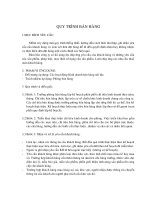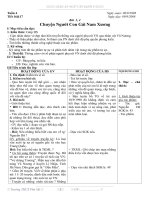4 3 drilling fluids
Bạn đang xem bản rút gọn của tài liệu. Xem và tải ngay bản đầy đủ của tài liệu tại đây (1.43 MB, 146 trang )
Network of Excellence in Training
Drilling Fluids
Technology
© COPYRIGHT 2000, NExT. All Rights Reserved
Fluids Technology
• Course Contents:
– Course Objectives,
– Basic Functions,
– Water & oil base muds,
– Formation damage,
– Completion fluids,
– Solids control,
– Environmental concerns,
– Performance testing.
2
© COPYRIGHT 2000,
All Rights Reserved
Drilling Fluids Technology
• Course Objectives:
– At the end of this course,YOU will be able to:
• List functions & properties of drilling and completion
fluis,
• Understand the formation damage
• Describe different fluids systems,
• Understand the solid control equipments
• Identify the environmental impact with drilling fluids.
3
© COPYRIGHT 2000,
All Rights Reserved
HISTORY & TECHNOLOGY
• 1900
Water and Clays
• Weighting Agent
No control of properties
Water base muds
• Controlled
• Polymers
• Mineral
Filtrate(‘50/’60’s)
( 70 ’s)
oils(‘80’s)
• Synthétics
4
(‘40’s)
(‘90’s)
Cellulosic polymers
PHPA systems
Formation compatibilty
Environmental
© COPYRIGHT 2000,
All Rights Reserved
Network of Excellence in Training
Section 1
Functions and Properties of
Drilling fluid
© COPYRIGHT 2000, NExT. All Rights Reserved
Functions & Properties
• Introduction;
– Drilling fluid is the lifeblood of drilling operations and
defined as :
• Circulating fluid,
• Drilling mud.
– Drilling fluid technology is dominated by three factors :
• Performance,
• Economics,
• Environmental concerns.
6
© COPYRIGHT 2000,
All Rights Reserved
Functions & Properties
• Technology;
– Drilling fluid is a mixture of barite, clay and other chemical
additives in a liquid phase,
– The liquid phase may be water, diesel or synthetic oil,
– A service company provide mud engineering services on
rigs.
7
© COPYRIGHT 2000,
All Rights Reserved
Functions & Properties
• Basic functions;
– The five primary drilling-fluid functions :
• Cool and lubricate the bit,
• Transport drilled cuttings to the surface,
• Control subsurface pressures,
• Deposit an impermeable wall cake,
• Avoid damage to productive zone,
8
© COPYRIGHT 2000,
All Rights Reserved
Functions & Properties
• Basic functions;
– Deposit an impermeable wall cake :
• The differential pressure will result an hydraulic invasion ,
• The mud or filtrate will enter into the formation ,
• The loss of mud into the wellbore will be expensive and
damaging,
• The loss of filtrate will cause formation damage,
• The cake will isolate the fluids from the formations.
9
© COPYRIGHT 2000,
All Rights Reserved
Functions & Properties
• Basic functions;
– Avoid damage to productive zone :
• The fluid used to drill the production zone will have an
important impact on well productivity ,
• Loss of production results from:
- Swelling clays,
- Reservoir pores blocked with solids and/or micro-emulsion
droplets.
1
0
© COPYRIGHT 2000,
All Rights Reserved
Functions & Properties
• Other functions;
– Additionally, the drilling fluid must :
• Help obtain information on subsurface formations,
• Protect the drill pipe against corrosion,
• Promote penetration rates,
• Allow interpretable logs.
1
1
© COPYRIGHT 2000,
All Rights Reserved
Properties
• Physical properties
– The primary performance requirement for a drilling fluid is
pressure control
– The density of any mud is directly related to the amont and
average specific gravity of the solids of the system,
– The control of density is important in that the hydrostatic
pressure exerted by the colum of fluid is required to contain
formation pressure and to aid in keeping the open hole,
• The density of any drilling fluids should be didacted by
formation pressures,
• The pressure exerted by the fluid comum should be equal to or
slightly higher than the formation.
1
2
© COPYRIGHT 2000,
All Rights Reserved
Properties
• Physical properties
– The control of density is important,
• The weight will need adjustment during a well operation,
• Weighting material as Barite will be used due to its specific
gravity ( 4.2 minimum),
• Under circulating conditions the effective pressure is increased
by the pumping pressure,
• The Equivalent Circulating Density
ECD = Density( ppg) + Annular pressure loss
Depth * 0.052
1
3
© COPYRIGHT 2000,
All Rights Reserved
Properties
• Rheology;
– The Rheology of drilling fluids and the associated annular
hydraulics relate directly the borehole cleaning ,and hole
stability,
– The Rheology is the study of the deformation of all forms of
matter and measures the internal resistance of a fluid to
flow,
– The deformation of a fluid can be described by two parallel
plates separated by some distance is known as the shear
stress .
1
4
© COPYRIGHT 2000,
All Rights Reserved
Properties
• Rheology-Characterisation of Fluids;
2 Platelets
F
v + dv
A
v
-The resistance or drag force is the shear stress
-The difference in the velocities divided by the
distance is called the shear rate
1
5
© COPYRIGHT 2000,
All Rights Reserved
Properties
• Rheology;
– Viscosity
• Shear Stress :
Unit : Lb / 100 ft 2
Force causing the shearing
Surface of the platelet
• Shear rate : Unit : 1 / sec ( reciprocal second)
Difference of velocity between 2 platelets
Distance between 2 platelets
1
6
© COPYRIGHT 2000,
All Rights Reserved
Properties
• Rheology: Apparent Viscosity
– Shear Stress and Shear Rate relation
• SHEAR STRESS
Unit :Centi poise
SHEAR RATE
-Newtonian fluid: the relationship is linear ( water,oil)
-Non Newtonian fluids :the shear stress does not increase in
direct proportion to the shear rate fluids
1
7
© COPYRIGHT 2000,
All Rights Reserved
Properties
• Rheology systems ;
Shear
stress
Bingham
Ostwald
Newtonian
Shear rate
1
8
© COPYRIGHT 2000,
All Rights Reserved
Properties
• Rheology and flow regimes;
– In 1833, Osborne Reynolds conducted experiments with various liquids flowing through a glass tube.
• The type of flow in which all the fluid motion is in the direction of flow, is now called laminar flow,
• A rapid, chaotic motion in all directions in the fluid is called turbulent flow,
• A fluid’s flow at extremely low flow rates is plug flow,
• The flow can alternate back and forth between laminar and turbulent ,it is a transitional flow.
1
9
© COPYRIGHT 2000,
All Rights Reserved
Properties
• Rheology - Laminar flow;
Velocity Profile ( Sliding motion )
Velocity is maximum at the center
2
0
© COPYRIGHT 2000,
All Rights Reserved
Properties
• Rheology - Turbulent flow;
Velocity Profile ( Swirling motion )
Average particle velocity is uniform
2
1
© COPYRIGHT 2000,
All Rights Reserved
Properties
• Rheology - Reynolds number;
– Reynolds number takes into consideration the basic factors of pipe flow :
• Pipe, diameter, average velocity, fluid density and fluid viscosity,
• Re= Velocity* pipe diameter* density / fluid viscosity
• Laminar < 2000- Transition - 3000 >Turbulent
The particular flow regime of a drilling fluid during
drilling operations can have a dramatic effect on parameters
such as pressure losses, hole cleaning and hole stability.
2
2
© COPYRIGHT 2000,
All Rights Reserved
Properties
• Rheology - Critical Velocity;
Shear stress
Turbulent Flow
Laminar Flow
Transition period
Critical velocity
Shear rate
2
3
© COPYRIGHT 2000,
All Rights Reserved
Properties
• Rheology;
– A gel structure is required to suspend the cuttings under
static conditions( zero shearing),
– The gels strength measures the tendency of a fluid to thicken
and the ability of a colloid to form a gel,
– Gel strength is a pressure unit,
• The common gel-strength measurements are initial and the
10 -min gels.
2
4
© COPYRIGHT 2000,
All Rights Reserved
Network of Excellence in Training
Section 2
Types of Drilling fluids
© COPYRIGHT 2000, NExT. All Rights Reserved









